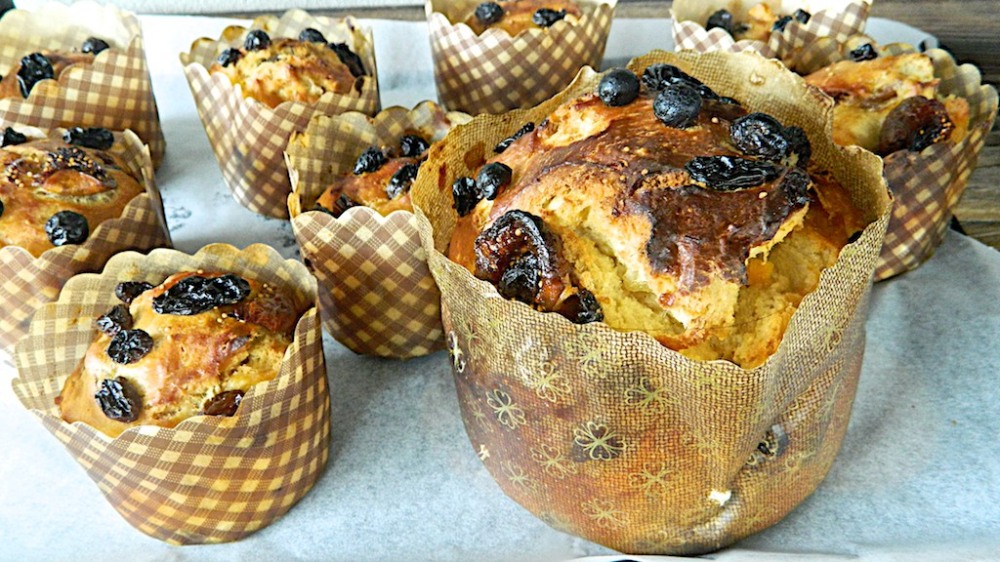Home-made Panettone with Figs and White Wine
Home-made Panettone with Figs and White Wine

step 1
-
350 gr (2-1/4 cups) of sultanas,
-
100 gr (1 cup) of raisins,
-
250 (2 cups) gr of semi dried figs, soaked in a bowl with 200 ml (3/4 cup) of rum and enough water to cover them.
-
Soak for a minimum of 3 hours, preferably overnight
step 2
Making the ferment (biga)
-
100 ml ( a little less than 1/2 cup)of milk
-
100 gr (3/4 cup) of flour
-
1 sachet of dry yeast
-
1 teaspoon of sugar or barley malt syrup.
-
Mix the ingredients in a bowl with a wooden spoon until combined.
-
Cover with a tea towel and leave to prove for 1-1 1/2 hours, or until bubbly and doubled in size.
Step 3
Risen dough from step 2
-
200 ml (3/4 cup) of white wine or Prosecco
-
300 gr (2-1/2 cups) of 00 flour (or plain)
-
3 tablespoons of sugar
-
2 tablespoon of soft butter
-
Work the risen ferment with a spoon, then the wine (or prosecco, if you feel extra festive), flour, sugar and the soft butter.
-
Knead until all the ingredients are well incorporated and the dough is soft and smooth.
-
Place back in the bowl, cover and leave to rest for 1 hour.
Step 4
Risen dough from step 3
-
290-320 gr (2- 3/4 cups) of 00 or Manitoba (or plain) flour
-
100 gr (1/2 cup) of sugar
-
3 tablespoons of honey
-
3 eggs
-
75 gr (1/3 cup) of soft butter, cubed
-
1 1/2 teaspoon of vanilla extract or paste
-
finely grated zest of 1 orange
-
dried fruit from step 1, drained
-
110 gr (1 cup) of candied peel dusted in a little flour.
-
Work the risen dough onto a floured board or use a standing mixer fitted with a dough hook (better option, if at all possible, because at this point the dough will be hard to handle),
-
add 290 gr (2 cups) of 00 or Manitoba flour (or plain flour, if specialty flours are hard to come by), sugar, honey and the eggs, one at a time.
-
The dough will be sticky and difficult to work, but don’t despair, it will come together in the end!
-
Add the butter and knead well to incorporate, adding 30-50 gr of extra flour if needed.
-
Mix in the vanilla and zest.
-
Knead for 20 minutes by hand or 7-10 minutes using a standing mixer, or until the dough is transparent and shiny when stretched with your fingers.
-
Drain the fruit that has been soaking.
-
Stretch the kneaded dough to shape a rectangle, cover with fruit and candied peel (if using), fold onto itself, then shape into a ball and leave to rest in an oiled bowl covered with a tea towel for 30 minutes.
Step 5
-
Stretch the dough with your hands to shape a rectangle, fold into three and then onto itself to form a ball.
-
Put the dough back in the oiled container and rest for 30 minutes.
-
Then repeat the stretching and folding one more time.
-
Place the dough to rest in the bowl covered with a tea towel for 2-3 hours or until doubled in size.
-
Folding the dough will ensure you an even and soft texture, with a moist, creamy crumb. Worth the pain!
Step 6
-
Prepare the moulds. This quantity will be enough for 2 large Panettone, 4 medium ones or 12 mini ones (perfect for edible gifts). Only fill the mould until it’s 3/4 full as the dough will rise in the oven when baking.
-
If not using a special panettone mould, you can use a round tin, lined with baking paper. Make sure to create a ring of paper tall enough to accommodate room for rising.
-
Prove the Panettone in its mould or tin for 2 hours at room temperature, uncovered, to encourage the formation of a slightly crusty top. Make sure to sit the mould or tin on a tray, to easily transport it to the oven when ready to bake.
-
In the meantime, bring your oven temperature to 180 C (380 F). Place an empty metal bowl or a skillet in the lower rack of the oven to heat up.
-
Slash a large X on the top of the panettone and place a large knob of butter in the middle.
-
Place the tray in the oven, fill the empty metal bowl or skillet with iced water to create steam and close the door. The steam will encourage even rising and moisture.
-
Bake for 45–55 minutes or until evenly risen and the colour of dark caramel. A wooden skewer inserted in the centre should come out moist, but not doughy. If it looks like it’s browning too fast, cover it with baking paper, but keep in mind that the crust is supposed to be quite dark.
-
As a general rule, a large panettone will take 45-50 minutes, a medium one 35-40 and mini ones 25-30.
-
Take the panettone out of the oven. If using a metal tin, let the bread cool completely in the pan before slicing and serving
-
If using a panettone mould, pierce two long metal skewers or knitting needles all the way through the bottom half of the panettone and through the paper.
-
Hang the panettone upside-down over a large stockpot or between two objects of equal height. Cool it for a minimum of 6 hours.

Love,
Silvia
Silvia’s Cucina is on Facebook , Twitter and Pinterest
This site contains product affiliate links. We may receive a commission if you make a purchase after clicking on one of these links.






